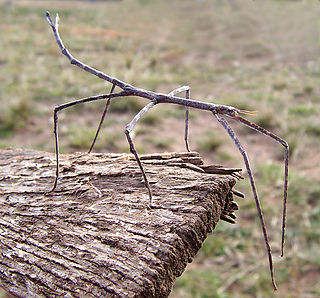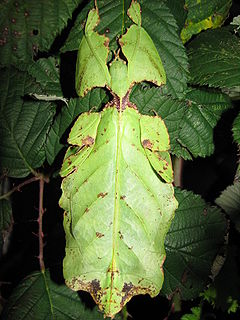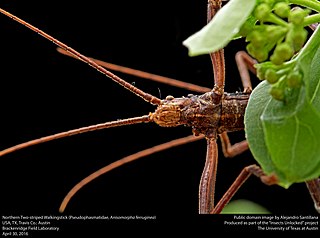
The Phasmatodea are an order of insects whose members are variously known as stick insects, stick-bugs, walking sticks, stick animals, or bug sticks. They are generally referred to as phasmatodeans, phasmids, or ghost insects. Phasmids in the family Phylliidae are called leaf insects, leaf-bugs, walking leaves, or bug leaves. The group's name is derived from the Ancient Greek φάσμα phasma, meaning an apparition or phantom, referring to their resemblance to vegetation while in fact being animals. Their natural camouflage makes them difficult for predators to detect; still, many species have one of several secondary lines of defense in the form of startle displays, spines or toxic secretions. Stick insects from the genera Phryganistria, Ctenomorpha, and Phobaeticus includes the world's longest insects.

The Phasmatidae are a family of the stick insects. They belong to the superfamily Anareolatae of suborder Verophasmatodea.

Anisomorpha is a genus of walking stick insect capable of secreting a substance from glands on the metathorax that can cause an intense burning irritation of the eyes and mouth of potential predators on contact. In some cases, this causes temporary blindness. Species are found throughout the mainland Central, northern South America, and the southeastern United States. The adult female is larger than the male in length and width. There are currently four accepted species in this genus, and all are wingless.

Ctenomorpha marginipennis, the margin-winged stick insect, is a species of stick insect endemic to southern Australia. The species was first described by George Robert Gray in 1833.

Pulchriphyllium giganteum, commonly known as the Giant Malaysian Leaf insect, is a species of leaf insects described from Malaysia by Hausleithner in 1984 and placed in the genus Pulchriphyllium since 2021. Pulchriphyllium giganteum is the largest species belonging to the genus Pulchriphyllium reaching 105 mm in size. They are found most abundantly in the west Malaysian tropics. The females typically have large elytra that lie edge to edge on the abdomen and tend to lack hind wings making them usually flightless. Males have small elytra and sometimes transparent non-leaflike functional hind wings. Pulchriphyllium giganteum found in the wild tend to be mostly females and the first male of this species was not found until 1994. In captivity, the species has primarily been observed to reproduce through parthenogenesis meaning the females are asexual. The primary reproductive pattern in the wild is unknown. Eggs tend to be brown or black and glossy and resemble the look of seeds. They hatch around 6 months after breeding. Newly hatched young nymphs tend to be wingless and brown or reddish in color. They develop their green color after feeding on leaves. Both the adult and larval stages are phytophagous meaning they feed on plants. The main plant food sources for this species are oak and bramble tree leaves.
Syneta is a genus of leaf beetles in the subfamily Synetinae. There are about 11 described species in Syneta. The genus is entirely holarctic in distribution, with species appearing in North America, Siberia, East Asia and Northern Europe.

Diapheromera arizonensis, the Arizona walkingstick, is a species of walkingstick in the family Diapheromeridae. It is found in North America.

Parabacillus hesperus, the western short-horn walkingstick, is a species of walkingstick in the family Heteronemiidae. It is found in North America. This species is found in dry, arid in the summer and fall. Their diet consists of various scrub and grassland plants. Through an adaptation called "crypsis," it blends in so perfectly with its natural habitat that it often goes completely undetected by would-be predators.

Anisomorpha ferruginea is a species in the family Pseudophasmatidae, in the order Phasmatodea ("walkingsticks"). Common names include "northern two-striped walkingstick", "dark walkingstick", and "prairie alligator". Anisomorpha ferruginea is found in North America.

Timema poppense, the "Pope Valley timema", is a species of walkingstick in the family Timematidae. It is found in California, and originally described from a nature reserve in the Pope Valley.

Diapheromera is a genus of stick insects in the family Diapheromeridae. There are about 14 described species in Diapheromera.

Heteronemiidae is a family of walkingsticks in the order Phasmatodea. There are about 14 genera and at least 80 described species in Heteronemiidae.
Canuleius is a genus of walkingsticks in the family Heteronemiidae. There are at least 20 described species in Canuleius.

Timema bartmani, or Bartman's timema, is a species of stick insect in the family Timematidae. It is found in North America.

Aschiphasmatidae are a family of stick insects belonging to the suborder Verophasmatodea; they can be found in Indomalaya.
Timema ritense, the Santa Rita timema, is a species of walkingstick in the family Timematidae. It is found in North America. The species was originally spelled "ritensis", but this spelling did not match the gender of the genus Timema, and therefore has undergone a mandatory change following ICZN Article 31.2.

Diapheromerini is a tribe of walkingsticks in the family Diapheromeridae. There are at least 30 genera Diapheromerini.
Anisacanthidae is a family of walkingsticks in the order Phasmatodea. There are about 10 genera and at least 30 described species in Anisacanthidae.
Damasippoididae is a family of walkingsticks in the order Phasmatodea. There are at least two genera and about six described species in Damasippoididae, found in Madagascar.
Parabacillus coloradus, the Colorado short-horn walkingstick, is a species of walkingstick in the family Heteronemiidae. It is found in North America.













